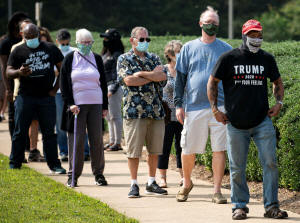Testing ahead of U.S. elections reveals struggle to quell disinformation
 Send a link to a friend
Send a link to a friend
 [September 23, 2020]
By Christopher Bing [September 23, 2020]
By Christopher Bing
WASHINGTON (Reuters) - U.S. election day
exercises simulating attacks ranging from hackers to anthrax to disrupt
voting show state and local officials will struggle to quickly counter
falsehoods flooding social media, according to five people familiar with
the tests.
The assessments come as U.S. intelligence officials and security
analysts expect an onslaught of digital misinformation surrounding the
election on November 3. Last week, National Security Agency Director
Gen. Paul Nakasone identified disinformation as the biggest threat to
the election.
The scenarios within the simulations included: exercises to test how
election officials would react to cyber-enabled electrical blackouts,
fake claims of ballot stuffing, fake bomb threats against polling
stations made from anonymous callers and fake claims of an anthrax
outbreak on election day in specific counties with close results.
The tests are critical because state and local officials who administer
elections will often be the first responders if disinformation on social
media spreads false information and begins to mislead voters.
These officials will also be among the first to report these examples to
social media firms like Facebook and Twitter to request the content be
removed, said Colorado Secretary of State Jena Griswold, who has staff
assigned to combat disinformation.

But even when content is taken down, convincing voters the information
was incorrect remains difficult.
"Will your response reach the same audience who was affected by the
disinformation? Can you still actually reach them if the disinformation
is successful? And is there the risk that the denial itself amplifies
the disinformation," said Thomas Rid, a disinformation expert at Johns
Hopkins University.
Since 2017, more than 25 states have conducted their own simulated
exercises, also known as "tabletops." The Cybersecurity and
Infrastructure Security Agency - a division of the Homeland Security
Department - has organized a total of 55 exercises, according to an
agency spokesman.
Cybereason, a Boston-based cybersecurity company, organized eight events
over the last two years, involving both state and local election
officials and federal agencies, a company spokesman said, with all of it
done pro-bono.
Most of the details about the simulation exercises remain confidential
and guests are discouraged from speaking to the media about them.
While election officials always seek to be the main source of voting
information, it's very difficult to do under urgent circumstances,
according to New Mexico Secretary of State Maggie Toulouse Oliver.
"Overall trying to get folks to know and understand who their local
election officials are and how they can get information directly from
them in a moment of crisis is an ongoing gap and challenge that we need
to figure out," Oliver added.
The FBI and Homeland Security Department said in a public service
announcement on Thursday that voters should always "seek out information
from trustworthy sources, such as state and local election officials"
because of the threat of disinformation from "foreign actors and
cybercriminals."
[to top of second column]
|

A man wears a shirt supporting U.S. President Donald Trump
while waiting in a socially distant line to vote on the
first day of early voting for the 2020 U.S. presidential
election at the Fairfax County Government Center in Fairfax,
Virginia, U.S., September 18, 2020. REUTERS/Al Drago

State election officials have poured millions of dollars into
digital advertising campaigns to reach voters and by growing their
own social media followings to rapidly address fake information,
Reuters previously reported, but progress is slow.
The lead election official in each state across the country often
has less than a few thousands social media followers who they can
immediately reach with an online posting. In Florida, a key
battleground between President Donald Trump and Joe Biden, the
Secretary of State only has about 2100 Twitter followers and no
Facebook account. In California, the Secretary of State’s “CA SOS
Vote” Twitter account has just 13,000 followers.
ELECTION GAMES
The scenarios have tested how the election officials in tandem with
federal partners would calm the public in an emergency situation,
share accurate information and retain control of the situation so
that the election could proceed normally.
They were not intended to test whether a specific state or agency
would fail, but several people involved in the simulation told
Reuters the experience has proven that the spread of purposefully
incorrect information to influence voter turnout in certain regions
was among the biggest challenges for election officials to overcome.
"It's eye opening, it gets you thinking about what could happen and
let's people plan," said Amber McReynolds, a former elections
director for Denver and early supporter of the exercises. "It's
often about communications issues, getting information out to the
public and adjusting plans."
"And it's funny because a lot of the time the communications folks
within states or counties do not get brought into the elections
operational conversations in advance, and they are actually a
critical partner," she said.

Disinformation around the election is already a problem. In late
August, an unknown number of Michigan voters received a robocall
that falsely warned residents of Detroit that voting by mail could
subject them to debt collection and forced vaccinations. Michigan's
attorney general has said it is investigating the incident.
It remains unclear who was behind the calls.
(Reporting by Christopher Bing; Editing by Chris Sanders and Edward
Tobin)
[© 2020 Thomson Reuters. All rights
reserved.] Copyright 2020 Reuters. All rights reserved. This material may not be published,
broadcast, rewritten or redistributed.
Thompson Reuters is solely responsible for this content. |